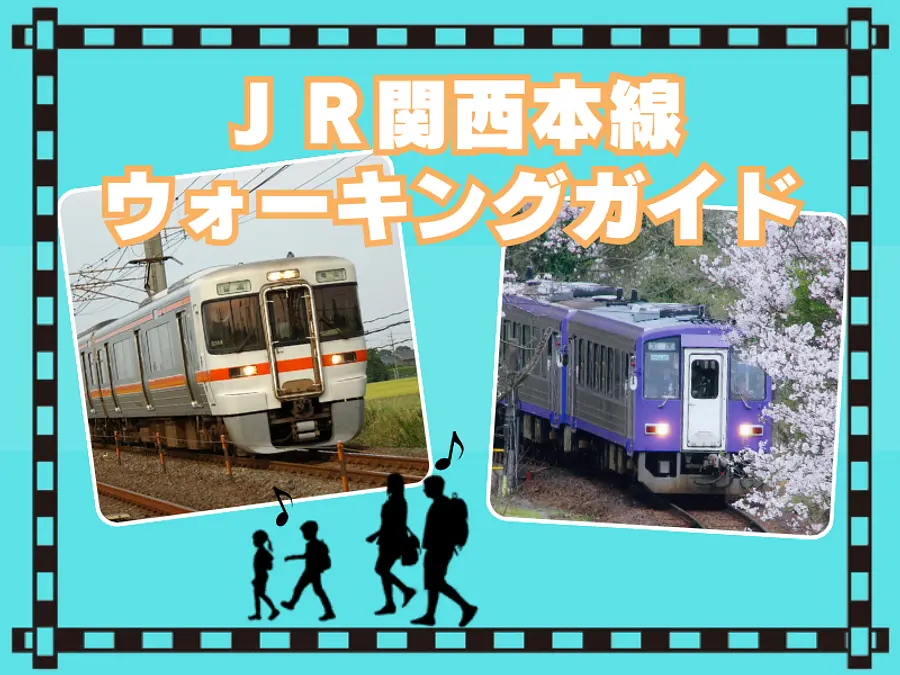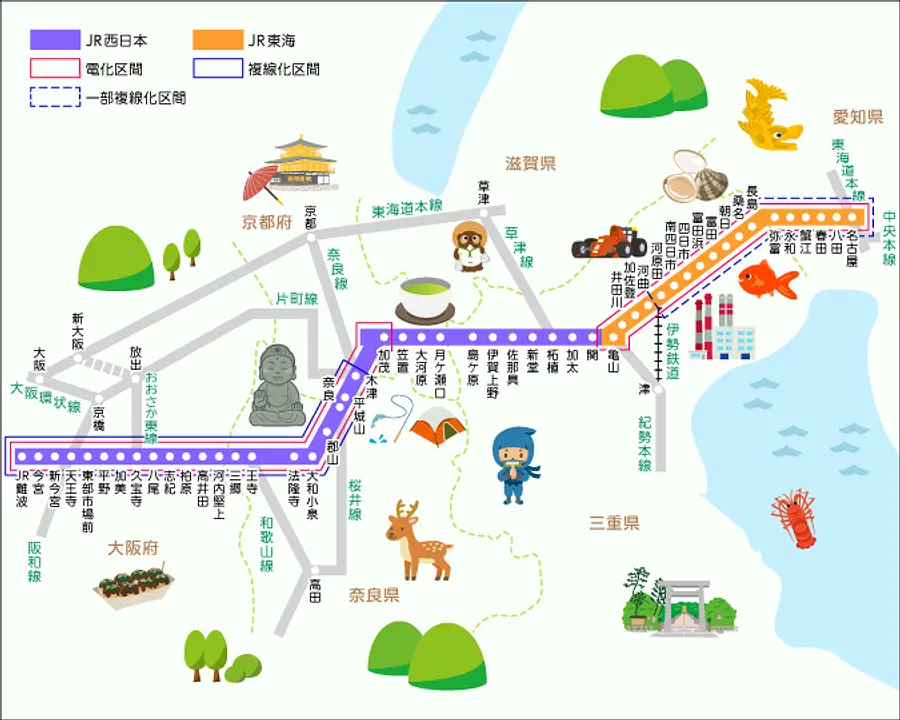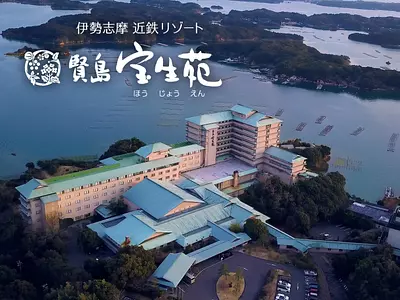Take the train! Walk! Kansai Main Line Walking Guide
掲載日:2024.03.15
The Kansai Main Line is a railway that straddles four prefectures: Aichi, Mie, Kyoto, and Nara, and connects Nagoya and Osaka in the shortest distance. In this article, we will introduce walking guides for each station and recommended spots around the stations.


What is the Kansai Main Line?
The Kansai Main Line (between Nagoya and JR Namba, operating km: 174.9 km) is the railway that connects Nagoya and Osaka over the shortest distance.
Osaka Railway opened the Kashiwara-Minatocho (currently JR Namba) section (16.1 km) in 1889 (Meiji 22), and other sections were opened by private operators, and in 1899 (Meiji 32). The entire route between Nagoya and Osaka was completed in 2010). After that, it was nationalized in 1907 (Meiji 40) and privatized in 1987 (Showa 62) (JR Tokai: 59.9 km between Nagoya and Kameyama, JR West: 115.0 km between Kameyama and JR Namba), and has reached its current status. I am.
In this article, we will introduce the charms of the four prefectures along the line (Aichi, Mie, Kyoto, and Nara).
Enjoy walking along the Kansai Main Line
Why not refresh your mind and body while walking along the Kansai Main Line, where you can enjoy a variety of attractions, from natural scenery to cityscapes?
Here, we will introduce walking courses that depart from and arrive at stations on the Kansai Main Line by prefecture and station.
- Aichi prefecture
Open station list
- Mie Prefecture
- Kyoto
Open station list
- Nara Prefecture
Open station list
Aichi prefecture
Nagoya Station (Nagoya City)
(Noritake Forest)
[Course name] (Walking distance: Approximately 3.5km Required time: Approximately 2 hours)
A walking course to enjoy Nagoya's past and present
The course recommended by Nagoya City starts from Nagoya Station, which is lined with skyscrapers, and while still being within walking distance, it takes you through Nagoya's current heritage and the Shikemichi, Endonji Shopping District, which retains the vestiges of Nagoya's manufacturing heritage and castle town. This is a course where you can enjoy the past.
Kanie Station (Kanie Town, Kaifu District)
(Sunari Festival/Yoi Festival)
[Course name] (Walking distance: Approximately 6.5km Required time: Approximately 2 hours)
Leisurely walking course through the UNESCO Intangible Cultural Heritage “Sunari Festival” and 100% natural hot springs
Kanie Town Tourism Exchange Center ``Matsurito'' was built in 2018 with the theme of the Sunari Festival, which was registered as a UNESCO Intangible Cultural Heritage in 2016. Using video technology such as projection mapping, you can realistically experience the history of the Sunari Festival, which has been passed down for more than 430 years.
Owari Onsen, the only hot spring in Aichi Prefecture that has been selected as one of the top 100 hot springs, is a 100% natural hot spring that is fed directly from the source, and is overwhelmingly high in quality and quantity. At ``Footbath Kanae no Sato'', you can directly use the hot spring water without adding water or heating it. You can soak in the natural hot spring water for free and enjoy a luxurious relaxing moment. Please come to Kanie Town, where you can feel the ancient history and the ultimate healing!
Eiwa Station (Aisai City)
(Oono Shrine)
[Course name] (Walking distance: Approximately 4.5km Required time: Approximately 1 hour 30 minutes)
A course where you can feel nature and history
Aisai City has many rivers, including the clear Kiso River, and is a city blessed with water and greenery, with a unique culture born from a deep relationship with water. There are also historical points around Eiwa Station, including the Ono Castle Ruins. Enjoy nature and history.
Yatomi Station (Yatomi City)
(YaToMiAQUA)
[Course name] (Walking distance: Approximately 6km Required time: Approximately 2 hours and 30 minutes)
Goldfish town walking course
Yatomi City is one of Japan's leading goldfish towns. After visiting the many cultural properties that tell the story of history from Yatomi Station and enjoying the view of the Kiso River and Suzuka mountains from Suigo Tower, head to the History and Folklore Museum and YaToMiAQUA. You can meet more than 20 varieties of goldfish. (Free guides are also available for groups.)
Mie Prefecture
Kuwana Station (KuwanaCity)
(Shichiri no Watari)
[Course name] (Walking distance: Approximately 6km Required time: Approximately 2 hours)
A walking course that explores history and culture
KuwanaCity is a city with a population of approximately 140,000 located in the northern part of Mie Prefecture. Boasting a rich natural environment such as the Kiso Mikawa water district and the rich greenery of the Tado Mountains, it is a key transportation hub where major trunk lines such as expressways, national highways, and Tokaido are concentrated. It is a town with a history and culture that flourished as a post town and castle town. Please take your time and enjoy the city of Kuwana, which is full of attractions.
Asahi Station (Asahi Town, AsahiTown)
(Model of the three-storied pagoda nao Temple)
[Course name] (Walking distance: Approximately 2km Required time: Approximately 1 hour)
A course where you can feel the history along with the eternal flow
Today, Banko-Yaki, which is famous as a local industry in YokkaichiCity such as purple mud teapots and earthenware pots, originated from a wealthy Kuwana merchant named Numami Yuzan who built a kiln in Komukai, Asahi Town in the Genbun period (1736-1741) of the AsahiTown obuke. It goes back to when I opened the. After Tozan's death, Banko-Yaki ceased for a time, but in 1832, Mori Arusetsu (real name Yogozaemon), who was born in Tamachi, Kuwana, opened a kiln in Naya, obuke, with his younger brother Chiaki. We have revived Banko-Yaki.
AsahiTown Educational and Cultural Facility's ``History Museum'' is where you can see nao ware from Banko-Yaki and a reliquary vessel with a Tang Sansai bowl (a nationally designated important cultural property) excavated from the ruins of an ancient temple, Nawou Abandoned Temple, thought to have been built during the Hakuho period. Visit us and delve into our timeless history.
Tomita Station - Yokkaichi Station (YokkaichiCity)
(Yokkaichi factory night view)
[Course name] (Walking distance: Approximately 10km Required time: Approximately 3 hours)
A course that traces the history of the port town of Yokkaichi
Yokkaichi flourished as a post town on Tokaido, and Yokkaichi Port continued to develop as one of Japan's leading ports. The old port near Yokkaichi Station has a blowout breakwater designated as an important cultural property, and the Kasumigaura area near Tomita Station is home to a group of stately petrochemical complexes. This is a walking route that takes you through the old and new ports of the port town of Yokkaichi.
Kasato Station (SuzukaCity)
(Kasato Shrine)
[Course name] (Walking distance: Approximately 3.5km Required time: Approximately 2 hours)
A course where you can enjoy tranquility and dynamism
Ise Bay to the east and the Suzuka Mountains to the west. SuzukaCity has both the sea and mountains. The Suzuka River flows gracefully from west to east almost in the middle. Kasato Station is located near the river. This area is dotted with various historic sites related to Japan's mythical hero Takeru Takeru, Tokugawa Iemitsu's nanny Kasuga Tsubone, and the chivalrous warrior Tateyoshira Nikichi, making it an interesting historical spot.
There are also modern spots such as Suzuka Flower Park, where you can enjoy flowering trees such as Satsuki, which boasts the highest production volume in Japan, and Swan Lake, which was created as a regulating pond, making it a perfect walking point where you can enjoy the tranquility and dynamism. .
Kameyama Station - Seki Station (KameyamaCity)
(Sekijuku)
[Course name] (Walking distance: Approximately 8.1km Required time: Approximately 3 hours 30 minutes)
Reminiscing about the travelers of the Edo period - A course where you can feel the eternal history
KameyamaCity prospered during the Edo period as one of the three post towns along the 53 stations of Tokaido, bustling with the comings and goings of feudal lords and travelers. Old townhouses still line the road, and traces of the area as a post town (Kameyama-juku, Sekijuku, and Sakashita-juku) remain in many places. Please take a leisurely stroll while tracing the vestiges of the Edo period.
kabuto Station (KameyamaCity)
(JR kabuto station building)
[Course name] (Walking distance: approx. 4.7km Required time: approx. 2 hours)
A course that takes you through railway heritage sites while experiencing the rich nature
The JR kabuto station building has been a famous station building since 1933, and was selected as one of the top 100 wooden station buildings in Japan.During the steam train boom of the 1960s, it was used as a steam locomotive to take on the Kansai Main Line's most difficult passage, kabuto Pass. It is also the station building where many railway fans disembark to take pictures of the majestic locomotives.
Additionally, on April 1, 2020, the station building was renovated and opened to improve convenience for railway users, disseminate information on historical tourism resources, and serve as a new hub for lively exchanges with the local community. Please take a trip to see the new kabuto station building and the remaining railway heritage sites in the surrounding area.
Tsuge Station (IgaCity)
(Statue of Basho Old Man)
[Course name] (Walking distance: Approximately 6.5km Required time: Approximately 2 hours)
A course to visit the hometowns of MatsuoBasho and Yokomitsu Riichi
Two people connected to Tsuge are the haiku master MatsuoBasho and the literary great Riichi Yokomitsu. Both are said to have spent part of their childhoods here. Depart from Mie Prefecture's first train station, Tsuge Station, and walk along Yamato Kaido. Why not think about these two great people while enjoying the charm of the road and strolling through the park?
Iga Ueno Station (IgaCity)
(Iga Ueno Castle)
[Course name] (Walking distance: Approximately 8km Required time: Approximately 3 hours)
A course to enjoy the castle town, visiting places related to ninjas and Basho
As the birthplace of the Iga-ryu ninja, IgaCity declared itself a ``Ninja City'' on February 22, 2017 in order to inherit the history and spirit of the ninja, as well as promote tourism and town development that utilizes the ninja. . There are many facilities related to ninjas and MatsuoBasho, and you can enjoy the atmosphere of the castle town of Iga Ueno. Danjiri Kaikan also has a local products shop (souvenir shop) and Iga Ueno Tourist Information Center.
Shimagahara Station (IgaCity)
(Iwatani Gorge (Kizugawa))
[Course name] (Walking distance: Approximately 12km Required time: Approximately 3 hours and 30 minutes)
Course to visit history and culture
The Shimagahara area has flourished as a transportation hub since ancient times, and the Yamato Kaido and Wado-no-michi roads, which still exist today, are frequented by many travelers, passing on various goods and culture to various places. The course focuses on Yamato Kaido, including Iwatani Gorge where clear streams flow through the rocks near Gyojado, difficult spots on Yamato Kaido called Yoemonzaka and Nagasaka, Hachi-no-Roku Jizo, which was created in the late Muromachi period, and more. In addition, near Nagasaka, you will pass through Basho's Shirimochizaka, where Basho is said to have died, and at the end of the course there is Shimagahara Onsen, where you can soothe the fatigue of your journey.
Kyoto
Tsukigaseguchi Station (Minamiyamashiro Village, Soraku District)
(Kizugawa)
[Course name] (Walking distance: Approximately 7.8km Required time: Approximately 2 hours 15 minutes)
A course blessed with rich nature and climate
Minamiyamashiro Village is adjacent to Nara, Shiga, and Mie Prefectures, and is surrounded by beautiful green mountains, with the majestic Kizugawa River flowing through the center, and is a village blessed with rich nature and climate. Located at the confluence where the Nabari River quietly intersects with the Kizugawa River flowing from Iga, ``Yumegen Gorge'' has been hailed as a scenic spot since ancient times.
In addition, Takayama Dam, which towers upstream, attracts many tourists throughout the year for its cherry blossoms, autumn leaves, fishing, and other attractions. You can take a leisurely stroll while feeling the various aspects of the village that change every moment with the sunrise. In Minamiyamashiro Village, all the free paths other than the walking courses are wonderful walking courses.
Kasagi Station (Kasagi Town, Soraku District)
(Kasagiyama Nature Park)
[Course name] (Walking distance: Approximately 4km Required time: Approximately 2 hours)
A course full of historic sites and scenic spots filled with historical romance
Located in Yamasa on the upper reaches of the Kizugawa River, this is a historic site and scenic village that exudes history and romance. You can feel the four seasons with your whole body, centered around Mt. Kasagi, which is designated as a national historic site and scenic spot.
In the spring, the cherry blossoms are in full bloom along the Kizugawa River, and in the summer, the campsite along the Kizugawa River is crowded with families camping and having barbecues. In the fall, the mountains of Kasagi turn brocade and you can enjoy autumn leaves viewing and hiking, and in the winter, you can enjoy hotpots made with Kasagi's specialty, pheasant.
Kamo Station (Kizugawa City)
(Joruriji Temple)
[Course name] (Walking distance: Approximately 15km Required time: Approximately 5 hours)
Course around national treasures and stone Buddhas
The Kamo area of Kizugawa City, where Kamo Station is located, is located between the ancient capitals of Kyoto and Nara, and has a rich history influenced by both cultures. It is a region where you can encounter beauty and nature. We will introduce courses in the Too area where you can easily enjoy walking using the Kizugawa City Community Bus (Kamo Bus) Too Line, which runs once an hour.
Nara Prefecture
Nara Station (Nara City)
(Nara Town Lively House)
[Course name] (Walking distance: Approximately 8.2km Required time: Approximately 2 hours 20 minutes)
A course full of Nara's highlights (Nara Park - Naramachi)
Take a walk through the beautiful scenery with over 1,300 years of history and fully experience the charm of the ``cultural properties of ancient Nara'' such as Todaiji Temple, Kofukuji Temple, and Kasuga Taisha Shrine, which are registered as World Cultural Heritage Sites. mosquito. In addition, in the area called ``Naramachi'' centered around the old grounds of Gangoji Temple, you can see beautiful townhouses with lattice doors built from the end of the Edo period to the Meiji period. The old townscape has a nostalgic atmosphere that gives visitors a sense of peace and relaxation, and sometimes even makes them feel nostalgic.
Koriyama Station (Yamatokoriyama City)
(Koriyama Castle ruins in spring)
[Course name] (Walking distance: Approximately 7km Required time: Approximately 2 hours and 30 minutes)
A course that takes you back in time to the bustling castle town
The Koriyama Castle ruins still retains the vestiges of once thriving as a castle town with a yield of 150,000 koku. The moss-covered stone walls and moat remain, and the Otemon gate and turret have been restored. Because of its shape, it was also called Inubushi Castle.When the castle was built, stones were brought in from around Nara, so many stone Buddhas and foundations were used in the stone walls, and stone art lovers still visit the castle ruins today. I will visit. As you walk through the townscape, you will see houses with a scent of history everywhere. Take a step into the maze of history with the Koriyama Castle ruins in the background.
Horyuji Station (Ikaruga Town, Ikoma District)
Ikaruga town course
(Horyuji Temple)
[Course name] (Walking distance: Approximately 8km Required time: Approximately 4 hours 30 minutes)
A historical heritage course where you can feel the passage of time
Ikaruga Town is home to a variety of historical and cultural heritage sites. Among them, the Buddhist buildings in the Horyuji area, such as Horyuji and Hokiji, are the world's oldest existing wooden buildings, and in December 1993, they were the first in Japan to be registered as a UNESCO World Cultural Heritage Site. The history of Ikaruga during the Kofun period is also attracting attention, as the Fujinoki Tumulus, which is said to have been built before Prince Shotoku moved to Ikaruga Palace, has been excavated without having been dug up. Even in the 21st century, these ruins from the Kofun period and buildings from the Asuka period can still be seen and felt in the natural surroundings of Ikaruga, and as you enjoy a leisurely stroll, you can reflect on its eternal history. Would you like to have some fun?
Antocho course
(Ando Town History and Folklore Museum)
[Course name] (Walking distance: Approximately 7.5km Required time: Approximately 3 hours)
A course to enjoy cultural assets full of emotion
The town of Ando, located slightly northwest of the center of the Nara Basin, is a rich land formed by the main rivers flowing through the town, where various cultures have developed since ancient times. It is recorded in the Shoku Nihongi that in the Nara period there was a place called ``Akuha-go'' and ``Akuha-miya'' (or ``Ashigaki-miya)''.
Kenkichi Tomimoto, a master of modern pottery, loved Ubusuna, his birthplace, and left many works with motifs of the landscapes and plants around Ando, and the area is dotted with cultural properties and old townscapes. However, there is no end to the number of people who are fascinated by the emotional atmosphere of Ando Town.
Oji Station (Oji Town, Kitakatsuragi District)
Ojimachi course
(Darumaji Temple)
[Course name] (Walking distance: Approximately 8km Required time: Approximately 3 hours)
A historical road course that follows Japan's original scenery
The town of Oji, where the Yamato River and Katsushita River flow, and is at the junction of the Kongo/Katsuragi Mountains and the Shiki/Ikoma Mountains, has long been attracting attention as the origin of Yamato culture. Why not take a look back at its eternal history by visiting the main historic sites in Oji Town?
Hatada/Myojin Mountain Course
(First sunrise (Mt. Myojin))
[Course name] (Walking distance: Approximately 11.5km Required time: Approximately 2 hours 40 minutes)
World heritage overlooking course
The course follows historical landmarks scattered along the route from JR Oji Station to Mt. Myojin. Why not get a feel for the history of Oji-cho by visiting historical sites?
Kawaicho course
(Market street)
[Course name] (Walking distance: Approximately 7km Required time: Approximately 4 hours)
A historical road course that follows Japan's original scenery
The cityscape along the Yamato River, which has been used as a waterway for transporting goods since ancient times, is a place where you can see nostalgic scenery where many people came and went. It is full of interesting historical spots, such as shrines that are in harmony with nature and ancient tombs that sit quietly.
Misato Station (Misato Town, Ikoma District)
(Tatsuta Taisha)
[Course name] (Walking distance: approx. 6.2km Required time: approx. 2 hours)
A course of natural and historical sites that fascinated even ancient people.
Misato Town is blessed with the beautiful natural environment of Kongo-Ikoma Kisen Quasi-National Park, and is full of seasonal nature around Mt. Shigi. To the northwest is Mt. Shigi Chogosonji Temple (in the Hegunmachi area), and Honmachi is the trailhead. The Yamato River located in the south is said to be the Tatsuta River, which was written about in poems in the Manyo period, and along with Mt. Mimuro, many ancient poems have been preserved. Other sites include Tatsuta Taisha Shrine, which was founded by Emperor Sujin and has a long history as the god of the wind, the Jizo Bosatsu statue at Kannonji Temple (Important Cultural Property), Yakuryuji Hachiman Shrine (Important Cultural Property), and was said to have been a resting place for Prince Shotoku. There are many ancient shrines and temples in the town that have valuable cultural properties, such as Heiryuji Temple, which is said to have been passed down.
About the Kansai Main Line Maintenance and Usage Promotion Federation
The Kansai Main Line Development and Usage Promotion Federation is comprised of four prefectures (Aichi, Mie, Kyoto, and Nara) and 20 municipalities along the line (Nagoya City, Aisai City, Yatomi City, Kanie Town, Yokkaichi YokkaichiCity, KuwanaCity, and SuzukaCity).・ KameyamaCity, IgaCity, AsahiTown, Kizugawa City, Kasagi Town, Minamiyamashiro Village, Nara City, Yamatokoriyama City, Misato Town, Ikaruga Town, Anto Town, Oji Town, Kawai Town), including utilization promotion projects. We are carrying out wide-area activities.
Kansai Main Line Maintenance and Usage Promotion Federation
Secretariat Mie Prefecture Transportation Policy Division
TEL 059-224-2622
EMAIL kotsu@pref.mie.lg.jp
| Category | |
|---|---|
| season | |
| area |



